Page 379 of 601
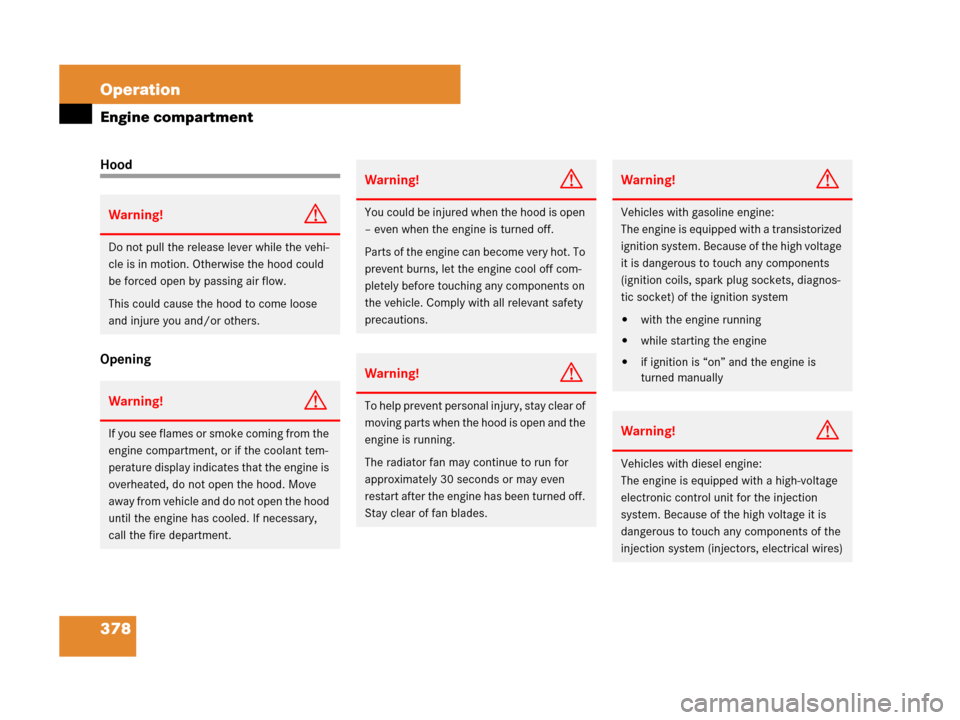
378 Operation
Engine compartment
Hood
Opening
Warning!G
Do not pull the release lever while the vehi-
cle is in motion. Otherwise the hood could
be forced open by passing air flow.
This could cause the hood to come loose
and injure you and/or others.
Warning!G
If you see flames or smoke coming from the
engine compartment, or if the coolant tem-
perature display indicates that the engine is
overheated, do not open the hood. Move
away from vehicle and do not open the hood
until the engine has cooled. If necessary,
call the fire department.
Warning!G
You could be injured when the hood is open
– even when the engine is turned off.
Parts of the engine can become very hot. To
prevent burns, let the engine cool off com-
pletely before touching any components on
the vehicle. Comply with all relevant safety
precautions.
Warning!G
To help prevent personal injury, stay clear of
moving parts when the hood is open and the
engine is running.
The radiator fan may continue to run for
approximately 30 seconds or may even
restart after the engine has been turned off.
Stay clear of fan blades.
Warning!G
Vehicles with gasoline engine:
The engine is equipped with a transistorized
ignition system. Because of the high voltage
it is dangerous to touch any components
(ignition coils, spark plug sockets, diagnos-
tic socket) of the ignition system
�with the engine running
�while starting the engine
�if ignition is “on” and the engine is
turned manually
Warning!G
Vehicles with diesel engine:
The engine is equipped with a high-voltage
electronic control unit for the injection
system. Because of the high voltage it is
dangerous to touch any components of the
injection system (injectors, electrical wires)
164.boo Seite 378 Freitag, 30. März 2007 12:54 12
Page 383 of 601
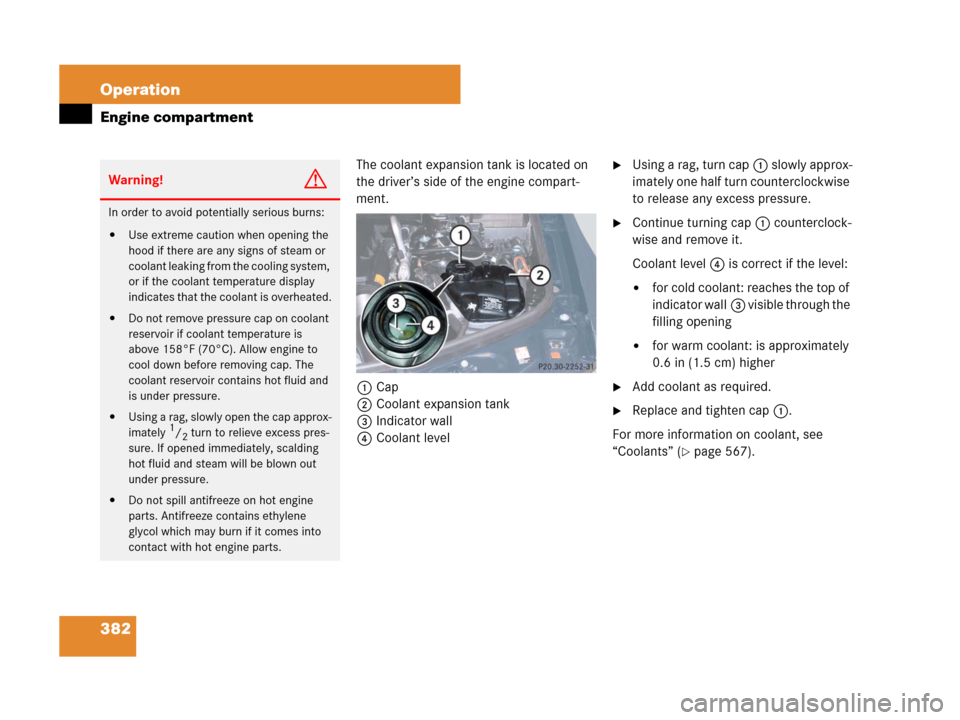
382 Operation
Engine compartment
The coolant expansion tank is located on
the driver’s side of the engine compart-
ment.
1Cap
2Coolant expansion tank
3Indicator wall
4Coolant level�Using a rag, turn cap1 slowly approx-
imately one half turn counterclockwise
to release any excess pressure.
�Continue turning cap1 counterclock-
wise and remove it.
Coolant level4 is correct if the level:
�for cold coolant: reaches the top of
indicator wall3 visible through the
filling opening
�for warm coolant: is approximately
0.6 in (1.5 cm) higher
�Add coolant as required.
�Replace and tighten cap1.
For more information on coolant, see
“Coolants” (
�page 567).
Warning!G
In order to avoid potentially serious burns:
�Use extreme caution when opening the
hood if there are any signs of steam or
coolant leaking from the cooling system,
or if the coolant temperature display
indicates that the coolant is overheated.
�Do not remove pressure cap on coolant
reservoir if coolant temperature is
above 158°F (70°C). Allow engine to
cool down before removing cap. The
coolant reservoir contains hot fluid and
is under pressure.
�Using a rag, slowly open the cap approx-
imately 1/2 turn to relieve excess pres-
sure. If opened immediately, scalding
hot fluid and steam will be blown out
under pressure.
�Do not spill antifreeze on hot engine
parts. Antifreeze contains ethylene
glycol which may burn if it comes into
contact with hot engine parts.
164.boo Seite 382 Freitag, 30. März 2007 12:54 12
Page 467 of 601
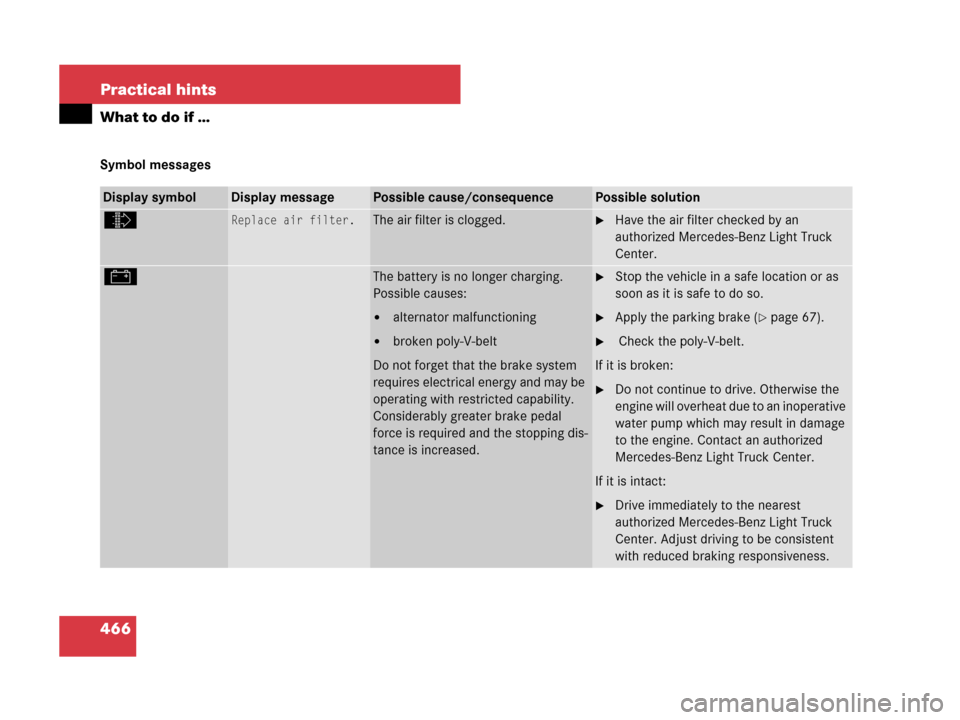
466 Practical hints
What to do if …
Symbol messages
Display symbolDisplay messagePossible cause/consequencePossible solution
ò Replace air filter.The air filter is clogged.�Have the air filter checked by an
authorized Mercedes-Benz Light Truck
Center.
#The battery is no longer charging.
Possible causes:
�alternator malfunctioning
�broken poly-V-belt
Do not forget that the brake system
requires electrical energy and may be
operating with restricted capability.
Considerably greater brake pedal
force is required and the stopping dis-
tance is increased.
�Stop the vehicle in a safe location or as
soon as it is safe to do so.
�Apply the parking brake (�page 67).
� Check the poly-V-belt.
If it is broken:
�Do not continue to drive. Otherwise the
engine will overheat due to an inoperative
water pump which may result in damage
to the engine. Contact an authorized
Mercedes-Benz Light Truck Center.
If it is intact:
�Drive immediately to the nearest
authorized Mercedes-Benz Light Truck
Center. Adjust driving to be consistent
with reduced braking responsiveness.
164.boo Seite 466 Freitag, 30. März 2007 12:54 12
Page 471 of 601
470 Practical hints
What to do if …
Display symbolDisplay messagePossible cause/consequencePossible solution
Ï Coolant Level
Stop car, switch engine off.The coolant is too hot.
Among other possible causes
(the cooling fan could be
malfunctioning), the poly-V-belt
could be broken.�Stop the vehicle in safe location or as
soon as it safe to do so.
�Apply the parking brake (�page 67).
�Turn off the engine.
�Check the poly-V-belt.
If it is broken:
�Do not continue to drive. Otherwise, the
engine will overheat due to an inoperative
water pump which may result in damage
to the engine. Contact an authorized
Mercedes-Benz Light Truck Center.
If it is intact:
�Do not continue to drive the vehicle with
this message displayed. Doing so could
result in serious engine damage that is
not covered by the Mercedes-Benz Limit-
ed Warranty.
(Continued on next page)
164.boo Seite 470 Freitag, 30. März 2007 12:54 12
Page 472 of 601
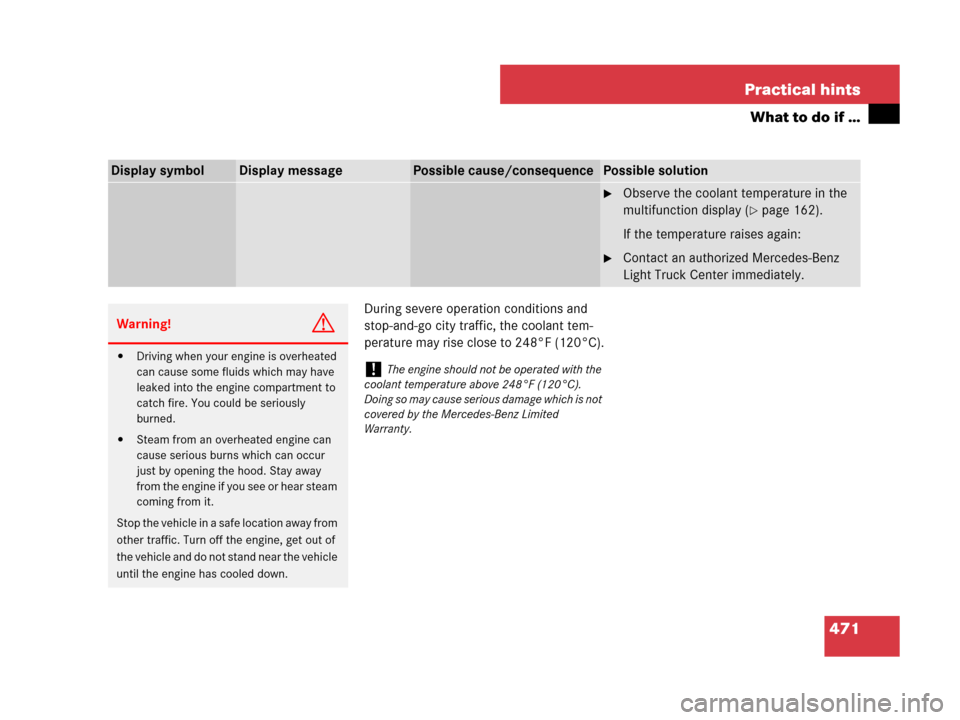
471 Practical hints
What to do if …
During severe operation conditions and
stop-and-go city traffic, the coolant tem-
perature may rise close to 248°F (120°C).
Display symbolDisplay messagePossible cause/consequencePossible solution
�Observe the coolant temperature in the
multifunction display (
�page 162).
If the temperature raises again:
�Contact an authorized Mercedes-Benz
Light Truck Center immediately.
Warning!G
�Driving when your engine is overheated
can cause some fluids which may have
leaked into the engine compartment to
catch fire. You could be seriously
burned.
�Steam from an overheated engine can
cause serious burns which can occur
just by opening the hood. Stay away
from the engine if you see or hear steam
coming from it.
Stop the vehicle in a safe location away from
other traffic. Turn off the engine, get out of
the vehicle and do not stand near the vehicle
until the engine has cooled down.
!The engine should not be operated with the
coolant temperature above 248°F (120°C).
Doing so may cause serious damage which is not
covered by the Mercedes-Benz Limited
Warranty.
164.boo Seite 471 Freitag, 30. März 2007 12:54 12
Page 473 of 601
472 Practical hints
What to do if …
Display symbolDisplay messagePossible cause/consequencePossible solution
B Top Up Coolant
See Operator’s ManualThe coolant level is too low.�Add coolant (�page 381).
�If you have to add coolant frequently,
have the cooling system checked by an
authorized Mercedes-Benz Light Truck
Center.
Warning!G
Do not spill antifreeze on hot engine parts.
Antifreeze contains ethylene glycol which
may burn if it comes into contact with hot
engine parts. You could be seriously burned.
!Do not ignore the low engine coolant level
warning. Extended driving with the message and
symbol displayed may cause serious engine
damage not covered by the Mercedes-Benz
Limited Warranty.
Do not drive without sufficient amount of coolant
in the cooling system. The engine will overheat
causing major engine damage.
164.boo Seite 472 Freitag, 30. März 2007 12:54 12
Page 489 of 601
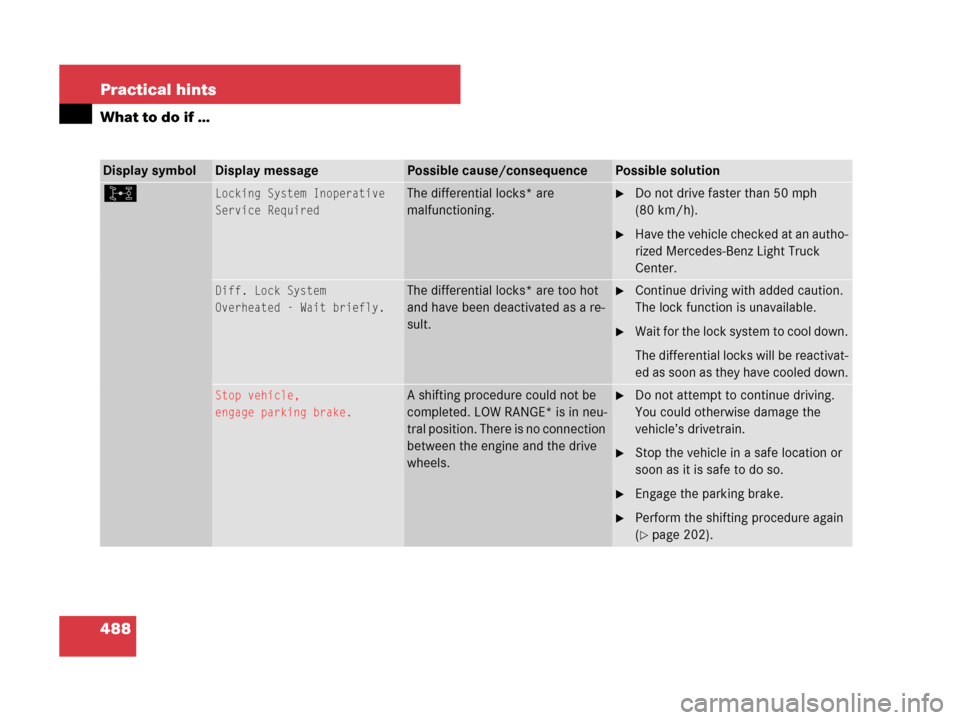
488 Practical hints
What to do if …
Display symbolDisplay messagePossible cause/consequencePossible solution
kLocking System Inoperative
Service RequiredThe differential locks* are
malfunctioning.�Do not drive faster than 50 mph
(80 km/h).
�Have the vehicle checked at an autho-
rized Mercedes-Benz Light Truck
Center.
Diff. Lock System
Overheated - Wait briefly.The differential locks* are too hot
and have been deactivated as a re-
sult.�Continue driving with added caution.
The lock function is unavailable.
�Wait for the lock system to cool down.
The differential locks will be reactivat-
ed as soon as they have cooled down.
Stop vehicle,
engage parking brake.A shifting procedure could not be
completed. LOW RANGE* is in neu-
tral position. There is no connection
between the engine and the drive
wheels.�Do not attempt to continue driving.
You could otherwise damage the
vehicle’s drivetrain.
�Stop the vehicle in a safe location or
soon as it is safe to do so.
�Engage the parking brake.
�Perform the shifting procedure again
(
�page 202).
164.boo Seite 488 Freitag, 30. März 2007 12:54 12